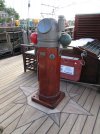Don't ships' magnetic compasses have magnets on them to compensate for the ship's magnetic field?
Absolutely correct.
Those need to be tweaked in such a way that they compensate the ship's magnetic field as much as possible.
I've once been involved with just that on the Maasdam.
We had an engineer on board to do it and we took the ship for two full 360 degree turns in Halifax harbour.
"Swinging the compass" it is called.
The result is an improved compass along with a Deviation card.
It's not possible to get this inaccuracy down to zero, but we got it below a maximum of 2 degrees.
That's pretty respectable I'd say and more than accurate enough to be useful.
Ship was a big lump of metal though.
I suppose on a wooden ship the inaccuracies should be much less.
Compass on my own boat has no compensation.
And though I haven't actively used it for pinpoint navigation, the numbers seem pretty accurate.
Polyester (plastic) boat. Not much metal around to mess things up.
This applies both for the regular and the 'fluxgate' one.
That second measures the magnetic field eletronically.
Useful to tie into digital onboard systems.
I now have a special compass on board that has a gyro chip also built in.
This measures the ship motions so it can subtract those from the compass heading.
That makes quite a difference on a small, bouncy ship.
It took me some substantial discussion with the supplier to gather how it worked.
They made it sound like a Gyro compass, but that seemed too unlikely to me.
Rightly so as it turned out to be
a gyro-stabilized Magnetic compass.
That makes a difference!
Because if you don't know what kind of compass you've got, you might start applying the wrong type of corrections.
And obviously that doesn't do any good...
Especially 'entertaining' when I was reading an official cabin sailboat handbook and it made mention of Gyro compasses.
I'm really curious if those even exist at all for (what I call) small boats.
For me, it just doesn't make sense...
They're too big. Too unweildy. Too heavy.
And too affected by vessel motions.
By the way, in addition to those two balls, there should also be a long, thin cylinder in the middle.
Probably on the other side of those photo's.
That's also part of the magnetic compensation.
















